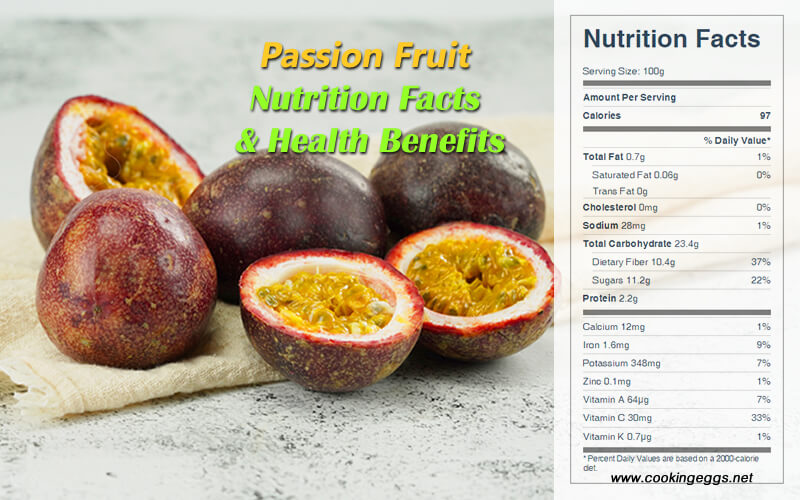Passion Fruit Nutrition Facts & Health Benefits
Passion fruit is one of the most intensely and enticingly scented of all fruits. Passion fruit is well known as the "king of fruits" because of its nutritional values and essential health benefits.
Passiflora edulis, commonly known as passion fruit, is a vine species of passion flower native to southern Brazil, through Paraguay and northern Argentina. Passion fruit is widely grown in tropical and semi-tropical regions of the world. In the United States, it is grown in Florida, Hawaii, and California.

The passion fruit is one of the most intensely and enticingly scented of all fruits. Cultivated in many tropical and temperate regions in the Americas, North Africa, and Australia, the passion fruit is known by many exotic-sounding names, including Maracuyá, Chinola, Parcha, Lilikoi, Granadilla, Sweet Cup, and many more. Passion fruit is likely the most recognized name for the fruit.
The fruit is a type of berry. The fruit produced is entirely fleshy and is spherical to ovoid. either yellow or dark purple at maturity, with a soft to firm, juicy interior filled with numerous seeds. Each seed is surrounded by a membranous sac filled with pulpy juice. The fruit is both eaten and juiced. The flavor of the juice is slightly acidic and musky. The juice is often added to other fruit juices to enhance the aroma. The passion fruit's flavor can be compared to that of the guava fruit. The fruits are usually eaten raw and are popular in fresh fruit salads, both the seeds and the pulp are edible. Many of the yellow-skinned passion fruits are grown for juice production.
Several distinct varieties of passion fruit with clearly differing exterior appearances exist. The bright yellow flavicarpa variety, also known as yellow or golden passionfruit, can grow up to the size of a grapefruit, has a smooth, glossy, light and airy rind, and has been used as a rootstock for purple passionfruit in Australia. The dark purple variety is smaller than a lemon, though it is less acidic than yellow passionfruit and has a richer aroma and flavour.
Generally, the purple varieties of passion fruit are grown in subtropical areas, whilst the yellow varieties and the giant granadilla need hot, moist tropical conditions. Purple varieties are picked by hand from the vines, whereas the yellow-skinned varieties are allowed to fall to the ground before being collected.
The nutritional value of passion fruit
Raw passion fruit is 73% water, 23% carbohydrates, 2.2% protein, and 0.7% fat. In a 100 gram reference amount, raw passion fruit supplies 97 calories and is a rich source of vitamin C and dietary fiber. It is also a moderate source of riboflavin, niacin, iron, and phosphorus.
Passion Fruit Nutrition Facts Label
Health Benefits of Passion Fruit
Passion fruit is rich in vitamin C and contains appreciable quantities of vitamins B1 and A. Passion fruit is well known as the "king of fruits" because of its nutritional values and essential health benefits. There are more than 100 identified polyphenols in passion fruit, and one serving of passion fruit contains up to 30 milligrams of vitamin C. Vitamin-C is a powerful water-soluble antioxidant.
Consumption of fruits rich in vitamin C helps scavenge harmful, pro-inflammatory free radicals by virtue of its antioxidant properties. Vitamin-C also boosts immunity to fight against flu infections.
Several studies have shown that pectin and fibers found in passion fruit can effectively eliminate free radicals. When compared to other fruits such as mango, pineapple, and banana, passionflower demonstrated a higher antioxidant capacity. This antioxidant capacity strengthens the immune system, primarily due to vitamin C, carotene, and cryptoxanthin. Current research studies suggest that these compounds, together with vitamin-A, help protect the retina. It is also essential for good eyes.
It is an excellent source of dietary fiber. The seeds of passionfruit contain 64% insoluble fiber.Insoluble fiber absorbs water throughout the digestive system, helping to promote regular, healthy bowel movements by binding with water and forming a gel that allows the body’s waste to rid the body of toxins.
A sufficient amount of fiber in the diet helps in controlling blood cholesterol and weight loss. Being a bulk laxative, it also helps protect the colon mucosa by wiping off any cancer-causing toxic substances from the colon.
Passion fruit possesses a polyphenol profile and a nutritional composition with significant benefits. Among these compounds, the most reported are luteolin, apigenin, and quercetin derivatives.
While passionflower develops into a fruit high in fiber and hundreds of identified phytochemicals, it’s broadly known for its antianxiety activity. There is a medical alkaloid in passion fruit called Harman, which functions as a sedative. This compound has been shown to reduce restlessness, insomnia, and anxiety, thus improving the quality of sleep.